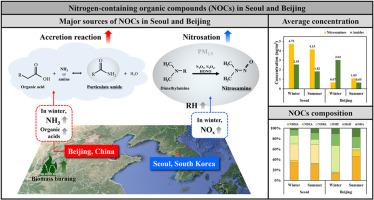Concentrations and formation pathways of nitrogen-containing organic compounds in PM2.5 from Seoul and Beijing
IF 7.7
2区 环境科学与生态学
Q1 ENVIRONMENTAL SCIENCES
引用次数: 0
Abstract
Organic nitrogen is an important constituent of organic aerosols, yet our understanding of the specific compounds, their concentrations, and atmospheric distribution remains limited. In this study, three nitrosamines (N-Nitrosodimethylamine, N-Nitrosodietylamine, and N-Nitrosodibutylamine) and three amides (N,N-Dimethylformamide, N-Hexadecanamide, and N-Octadecanamide) in atmospheric particulate matter with an aerodynamic diameter of equal to or less than 2.5 μm (PM2.5), collected in Seoul, South Korea, and Beijing, China, during winter in 2020 and summer in 2021, were analyzed to characterize their concentrations and major contributors. Nitrosamines and amides were found to have distinct distributions under different atmospheric conditions and aerosol properties. Total nitrosamine concentrations were higher in Seoul (5.11 ± 10.13 ng/m3 (winter); 4.15 ± 3.91 ng/m3 (summer)) than in Beijing (0.75 ± 1.59 ng/m3 (winter); 1.09 ± 1.50 ng/m3 (summer)). Total amide concentration was slightly higher in Beijing (2.73 ± 1.84 ng/m3) than in Seoul (2.54 ± 2.84 ng/m3) during winter, while in summer, the concentration in Beijing (0.65 ± 0.49 ng/m3) was much lower than in Seoul (1.82 ± 0.90 ng/m3). Seoul appeared to show higher relative humidity (RH) and aerosol liquid water content concentration compared to Beijing, which may have contributed to elevated nitrosamine concentrations, potentially through enhanced aqueous-phase nitrosation reactions. Meanwhile, amides seemed to demonstrate increased uptake into PM2.5 and possibly participated in accretion reactions yielding particulate products, particularly under the lower RH conditions observed in Beijing. These findings suggest that atmospheric conditions, such as RH, may influence the distribution patterns of nitrogen-containing organic compounds in the atmosphere.

首尔和北京PM2.5中含氮有机物的浓度及其形成途径
有机氮是有机气溶胶的重要组成部分,但我们对具体化合物、它们的浓度和大气分布的了解仍然有限。本研究分析了2020年冬季和2021年夏季在韩国首尔和中国北京收集的空气动力学直径等于或小于2.5 μm (PM2.5)的大气颗粒物中的三种亚硝胺(N-亚硝基二甲胺、N-亚硝基二乙胺和N-亚硝基二乙胺)和三种酰胺(N,N-二甲基甲酰胺、N- hexadecanamide和N- octadecanamide),以表征它们的浓度和主要贡献者。亚硝胺类和酰胺类在不同的大气条件和气溶胶性质下具有不同的分布。汉城地区总亚硝胺浓度较高,冬季为5.11±10.13 ng/m3;4.15±3.91 ng/m3(夏季)比北京(0.75±1.59 ng/m3(冬季))高;1.09±1.50 ng/m3(夏季))。冬季北京总酰胺浓度(2.73±1.84 ng/m3)略高于首尔(2.54±2.84 ng/m3),夏季北京总酰胺浓度(0.65±0.49 ng/m3)远低于首尔(1.82±0.90 ng/m3)。与北京相比,首尔的相对湿度(RH)和气溶胶液态水含量浓度似乎更高,这可能是通过加强水相亚硝化反应导致亚硝胺浓度升高的原因。与此同时,在北京观测到的较低相对湿度条件下,酰胺似乎表现出对PM2.5的吸收增加,并可能参与产生颗粒产物的增加反应。这些发现表明,大气条件,如RH,可能会影响大气中含氮有机化合物的分布模式。
本文章由计算机程序翻译,如有差异,请以英文原文为准。
求助全文
约1分钟内获得全文
求助全文
来源期刊

Environmental Research
环境科学-公共卫生、环境卫生与职业卫生
CiteScore
12.60
自引率
8.40%
发文量
2480
审稿时长
4.7 months
期刊介绍:
The Environmental Research journal presents a broad range of interdisciplinary research, focused on addressing worldwide environmental concerns and featuring innovative findings. Our publication strives to explore relevant anthropogenic issues across various environmental sectors, showcasing practical applications in real-life settings.
 求助内容:
求助内容: 应助结果提醒方式:
应助结果提醒方式:


